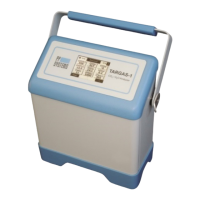TARGAS-1 Operation Manual V. 1.02 150 support@ppsystems.com
Appendix 1. Photosynthesis Equations Used in
TARGAS-1
Mass Flow
Calculate the mass flow of air () entering the cuvette per unit leaf area
(A.1) The TARGAS-1 mass flowmeter is calibrated to read the volume flow (
) at 0 °C and 1013.25 mb
(STP). The Ideal Gas molar volume is 22.414 L mol
-1
at STP. Therefore:
(
)
=
×
×
.
×
where:
= projected leaf area (measured in cm
2
converted above to m
2
)
= volume flow (measured in cc min
-1
converted above to L sec
-1
)
Note that and all subsequent equations are presented as quantities per unit leaf area. The projected
leaf area is an input to the TARGAS-1 software to correctly compute gas exchange results. The PLC5
window area is 4.5 cm
2
, and this is the default leaf area used in calculations. However, if measurements
are made with leaves that don't completely fill the window, the actual Leaf Area should be entered in
Measure Screen 2
prior to making measurements. Alternately, if the Leaf Area is not known at the time of
measurements, PP Systems provides a simple TARGAS-1 Excel
®
spreadsheet program that allows
recalculation of all gas exchange results with different Leaf Area.
Transpiration
Calculate transpiration rate () from the partial pressures of water vapor of the air entering (
) and
exiting (
) the cuvette
(A.2) The molar flow of water vapor (mol m
2
s
-1
) into the cuvette is:
×
(A.3) The molar flow of air out of the cuvette (with the addition of transpired water vapor) is (+ ).
Therefore, the molar flow of water vapor out of the cuvette is:
(
+
)
×
(A.4) However, the difference between the molar flows into and out of the cuvette must equal the
transpiration, so:
=
(
+
)
×
×
(A.5) Therefore:
(
)
=
×
(
)
(
)
×

